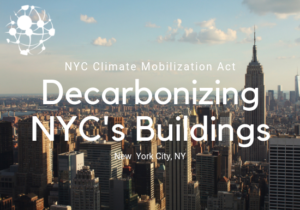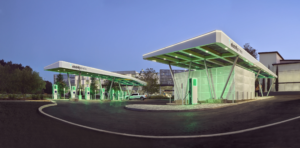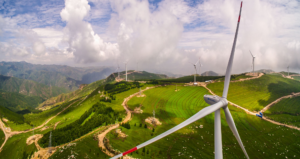In This Issue
- Flanigan’s Eco-Logic: Let’s Keep an Eye on the Ball
- Decarbonizing New York City
- Toyota’s Big EV Shift
- EV Updates: Blade Batteries, The Ford Lightning, 1 Million Sold in California
- The Drive-in Diner Comeback?
- Pairing Crops with Solar
- Blue and Green, Hydrogen and Ammonia
- The National Electric Highway Coalition
- Chinese Wind Production
- The NetPositive Podcast Updates

Flanigan’s Eco-Logic: Let’s Keep an Eye on the Ball
Just three days after an unprecedented stampede of tornadoes ripped through Kentucky and its neighboring states on December 10, California policymakers were in the process of rolling back a hugely successful solar policy called Net Energy Metering. Climate change be damned.
Record and devastating storms worldwide are the result of human-induced climate change. It is upon us… so we’re scrambling for solutions… means to cut CO2 from getting into the atmosphere. A primary means of doing that in the electricity sector — long known for its dirty coal-burning power plants — has been to promote renewable energy. We’re cleaning the grid in leaps and bounds.
Net energy metering has helped homeowners, schools, and businesses develop a network of distributed, renewable energy resources. This is unquestionably good for our climate. Like the federal tax credit (ITC), Net Energy Metering (NEM) helps consumers get compensated for their investments in solar. The deal is simple: when a solar system over generates, it gets credit for those times that a home or business needs to draw from the grid, for instance at night. This flexibility has ushered in a strong solar movement in our communities.
But instead of recognizing the need to maintain growth in this industry, much less to accelerate climate mitigation measures, at the instigation of California’s investor-owned utilities, the California Public Utilities Commission took a big, bad swing at distributed solar. The range of “NEM reforms” considered by the CPUC included monthly fees, shorter grandfathering terms for favorable tariffs, lower export values, and even a kWh charge for self-generation! See EcoNet News Volume 23, Issue #1 for a discussion of the options.
After months of deliberations and lobbying on all sides, the CPUC’s proposed decision, strips local solar of important incentives and instead imposes draconian fees on those who invest in solar to care for the planet.
Need we not keep our eye on the ball? Tornadic activity, fires, floods, droughts, wind storms, hurricanes… all increasing in frequency and ferocity. I salute all those Americans who have invested in solar, and who have taken big actions on their homefronts to address the climate reality head-on. Now others that do so will be taxed with monthly fees and less credit values.
Sure, there are subsidies and equity issues. We need solar (and now storage) programs for all. We need rooftop solar. We need community solar. We need utility-scale solar. To combat climate change, and fast, we need it all. Look at the progress. A solar industry is now rooted in our communities. Prices are coming down, and now storage can be paired with solar for resiliency. You can’t get that with utility-scale solar in the desert. And we have local jobs helping to beat back climate havoc.
Yes, it is more expensive to build on rooftops than in the desert… but the benefits are huge and now are being stripped away in favor of a narrow view of cost effectiveness. Imagine the costs of climate change. Huge and born by all ratepayers. Inaction on climate protection will cost us all more than any form of NEM. This is the big picture. This is keeping our eye on the ball. And now, our voices must be strong.

Beneficial rooftop solar is in peril. Not a good way to end the year. This is not a present for the future, but a big step backwards. Should a proposed decision become final, the household solar industry in California will be severely impacted. Less solar. Right when we clearly need it most. Can we stand policies that retard progress to a clean energy future? No.
Sure, if you only made state policy through a lens of financial cost effectiveness for our utilities – one of the most polluting sectors in our society – we’ll suffer from severe impacts of climate. But we well know that utilities must be regulated to achieve certain objectives, some economic of source, others environmental, and others societal. It isn’t just about the money… we’re on a mission to green our power system and to save the world.
The general manager of our local utility has been tracking the CPUC action. He intends to follow suit on NEM. So will many other utility leaders. California’s illogic may be emulated by other states. Sure, no one wants to pay too much for distributed solar… but we all want/need these resources to augment utility-scale renewables. Let’s pair solar with storage for maximum system benefit and for resiliency at the household level. But replicating California’s solar stab is the kind of climate leverage we simply cannot tolerate.

 Good old Ithaca, New York. Population 30,000. I think Cornell. It’s a “cold corner” of New York, tough winters, summers that are too short. There’s lots of heating oil and natural gas burned in boilers and furnaces to warm the City’s 6,000 homes and buildings.
Good old Ithaca, New York. Population 30,000. I think Cornell. It’s a “cold corner” of New York, tough winters, summers that are too short. There’s lots of heating oil and natural gas burned in boilers and furnaces to warm the City’s 6,000 homes and buildings. Toyota has heretofore been criticized for its position on electric vehicles. It’s been viewed as an EV laggard. For years it bet on hydrogen fuel cells and hybrid vehicles. Toyota lobbied against EVs, and worse, it has been accused of spreading misinformation to tamp down EV enthusiasm and sales.
Toyota has heretofore been criticized for its position on electric vehicles. It’s been viewed as an EV laggard. For years it bet on hydrogen fuel cells and hybrid vehicles. Toyota lobbied against EVs, and worse, it has been accused of spreading misinformation to tamp down EV enthusiasm and sales. BYD’s Blade Battery has attracted lots of attention. The cells are made with lithium iron phosphate chemistry (LFP) and are less costly and safer. The BYD Blade Battery pack runs cool with fireproof chemistry and configuration. It has an intrinsically safer cathode. LFP and NMC are two different sub-chemistries of lithium-ion batteries. While LFP uses the lithium iron phosphate as cathode material, NMC (commonly used in EVs) uses lithium, manganese, and cobalt.
BYD’s Blade Battery has attracted lots of attention. The cells are made with lithium iron phosphate chemistry (LFP) and are less costly and safer. The BYD Blade Battery pack runs cool with fireproof chemistry and configuration. It has an intrinsically safer cathode. LFP and NMC are two different sub-chemistries of lithium-ion batteries. While LFP uses the lithium iron phosphate as cathode material, NMC (commonly used in EVs) uses lithium, manganese, and cobalt.
 A new study from the University of Illinois presents findings on pairing agriculture with solar. It finds a synergy between two forms of useful production that have been perceived to be competitive for precious land. A $10 million grant-funded the “agrivoltaics” study which focused on how to “sustainably co-locate ag and photovoltaic systems.” This has a fancy name: SCAPES which stands for Sustainable Colocating Agricultural and Photovoltaics Electricity Systems. Row crops, foraging crops (for livestock) and speciality crops will be studied across three biophysically diverse regions of the country: Illinois, Colorado, and Arizona. Ideally, through colocation, the combined benefit is greater than the benefit of a single use.
A new study from the University of Illinois presents findings on pairing agriculture with solar. It finds a synergy between two forms of useful production that have been perceived to be competitive for precious land. A $10 million grant-funded the “agrivoltaics” study which focused on how to “sustainably co-locate ag and photovoltaic systems.” This has a fancy name: SCAPES which stands for Sustainable Colocating Agricultural and Photovoltaics Electricity Systems. Row crops, foraging crops (for livestock) and speciality crops will be studied across three biophysically diverse regions of the country: Illinois, Colorado, and Arizona. Ideally, through colocation, the combined benefit is greater than the benefit of a single use. The tanker shipment of blue ammonia to Japan caught my attention. Aramco and partners are boasting the world’s first – and now third – blue ammonia shipment. Aramco and the Institute of Energy Economics successfully demonstrated the production and shipment of blue ammonia – initially 40 tons – from Saudi Arabia to Japan with support from the Japanese Ministry of Economy, Trade, and Industry. High-grade blue ammonia was dispatched to Japan for zero-carbon power generation.
The tanker shipment of blue ammonia to Japan caught my attention. Aramco and partners are boasting the world’s first – and now third – blue ammonia shipment. Aramco and the Institute of Energy Economics successfully demonstrated the production and shipment of blue ammonia – initially 40 tons – from Saudi Arabia to Japan with support from the Japanese Ministry of Economy, Trade, and Industry. High-grade blue ammonia was dispatched to Japan for zero-carbon power generation. The Edison Electric Institute (EEI) has announced the formation of the National Electric Highway Coalition. It’s made up of 51 investor-owned utilities, one electric cooperative, and the Tennessee Valley Authority. Its goal is to provide electric vehicle fast-charging ports along major U.S. travel corridors by the end of 2023. The current Coalition members serve nearly 120 million electricity customers across 47 states and the District of Columbia.
The Edison Electric Institute (EEI) has announced the formation of the National Electric Highway Coalition. It’s made up of 51 investor-owned utilities, one electric cooperative, and the Tennessee Valley Authority. Its goal is to provide electric vehicle fast-charging ports along major U.S. travel corridors by the end of 2023. The current Coalition members serve nearly 120 million electricity customers across 47 states and the District of Columbia. Reminded, I am, this time of year about consumerism… and how much stuff we buy. It’s oft swathed in packaging. Much of it comes from China, “the world’s factory” and the world’s leading GHG polluter. Producing stuff we buy.
Reminded, I am, this time of year about consumerism… and how much stuff we buy. It’s oft swathed in packaging. Much of it comes from China, “the world’s factory” and the world’s leading GHG polluter. Producing stuff we buy. Recently Released:
Recently Released: